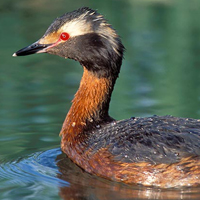Horned grebe
Scientific name: Podiceps auritus

Cover photo credit: Brian E. Small
Status
Special Concern
“Special Concern” means the species lives in the wild in Ontario, is not endangered or threatened, but may become threatened or endangered due to a combination of biological characteristics and identified threats.
Date added to the Species at Risk in Ontario List
September 10, 2009
What it looks like
The Horned Grebe is a small duck-like waterbird 31-38 cm long with a short, pointed bill. In breeding plumage, the Horned Grebe has a black head with a distinctive patch of golden yellow feathers behind its eye called “horns.” The front of its neck and upper breast are reddish. Males and females look similar, although males are typically brighter than females in breeding plumage.
Where it lives
The Horned Grebe usually nests in small ponds, marshes and shallow bays that contain areas of open water and emergent vegetation. Nests are usually located within a few metres of open water. This vegetation provides adults with nest materials, concealment, and protection for their young. The Horned Grebe occupies natural habitat more often than man-made reservoirs and artificial ponds.
Where it’s been found in Ontario
The Horned Grebe is found across North America and Eurasia. Most of its North American breeding range is located in Canada, extending from northwestern Ontario to British Columbia and north to Alaska (Western population). A small, isolated breeding population also exists in Quebec, where it is limited to the Magdalen lslands.
The Horned Grebe is a rare breeder in Ontario. Following the breeding season, most individuals migrate from inland freshwater nesting sites to coastal marine sites, although some individuals overwinter on large bodies of freshwater.
What threatens it
It is not known why the Horned Grebe is declining across North America. It is expected that populations are threatened by the permanent loss of wetlands to agriculture and development. Widespread and recurring droughts across the prairies have also resulted in loss of wetlands.
Action we are taking
Special concern species do not receive species or habitat protection.
Management plan
A management plan advises the ministry on ways to ensure healthy numbers of the species return to Ontario.
Read the management plan (September 10, 2014).
Government response statement
A government response statement outlines the actions the government intends to take or support to help recover the species.
Read the government response statement (June 10, 2015)
What you can do
Report a sighting
- Report a sighting of an endangered animal or plant to the Natural Heritage Information Centre. Photographs with specific locations or mapping coordinates are always helpful.
- Bird Studies Canada is working to advance the understanding, appreciation and conservation of wild birds and their habitat in Ontario and elsewhere. For more information on how you can help, visit the Bird Studies Canada website.
Volunteer
Volunteer with your local nature club or provincial park to participate in surveys or stewardship work focused on species at risk.
Be a good steward
Private land owners have a very important role to play in species recovery. You may be eligible for stewardship programs that support the protection and recovery of species at risk and their habitats.
Report illegal activity
Report any illegal activity related to plants and wildlife to
Quick facts
- Horned Grebes are awkward on land and spend the majority of their time swimming or floating on the water. A sleeping Horned Grebe rests its neck on its back and tucks one of its feet under a wing. It uses the other foot to manoeuvre in the water.
- In order to be concealed from predators, Horned Grebes build cryptic, floating nests in mats of emergent vegetation. Nests are affixed to aquatic vegetation or exposed rocks so that they don’t float away. Some parents construct nests on exposed rocks or along the shoreline.